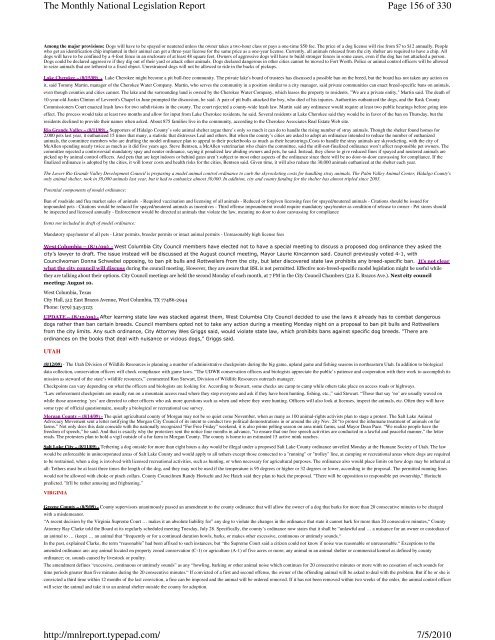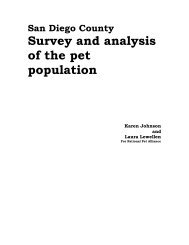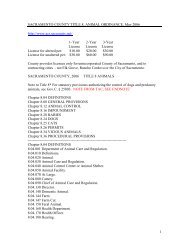Page 1 of 330 The Monthly National Legislation Report 7/5/2010 ...
Page 1 of 330 The Monthly National Legislation Report 7/5/2010 ...
Page 1 of 330 The Monthly National Legislation Report 7/5/2010 ...
Create successful ePaper yourself
Turn your PDF publications into a flip-book with our unique Google optimized e-Paper software.
<strong>The</strong> <strong>Monthly</strong> <strong>National</strong> <strong>Legislation</strong> <strong>Report</strong>http://mnlreport.typepad.com/<strong>Page</strong> 156 <strong>of</strong> <strong>330</strong>7/5/<strong>2010</strong>Among the major provisions: Dogs will have to be spayed or neutered unless the owner takes a two-hour class or pays a one-time $50 fee. <strong>The</strong> price <strong>of</strong> a dog license will rise from $7 to $12 annually. Peoplewho get an identification chip implanted in their animal can get a three-year license for the same price as a one-year license. Currently, all animals released from the city shelter are required to have a chip. Alldogs will have to be confined by a 4-foot fence in an enclosure <strong>of</strong> at least 48 square feet. Owners <strong>of</strong> aggressive dogs will have to build stronger fences in some cases, even if the dog has not attacked a person.Dogs could be declared aggressive if they dig out <strong>of</strong> their yard or attack other animals. Dogs declared dangerous in other cities cannot be moved to Fort Worth. Police or animal control <strong>of</strong>ficers will be allowedto seize animals that are tethered to a fixed object. Unrestrained dogs will not be allowed to ride in the backs <strong>of</strong> pickups.Lake Cherokee – (8/15/09) - Lake Cherokee might become a pit bull-free community. <strong>The</strong> private lake's board <strong>of</strong> trustees has discussed a possible ban on the breed, but the board has not taken any action onit, said Tommy Martin, manager <strong>of</strong> the Cherokee Water Company. Martin, who serves the community in a position similar to a city manager, said private communities can enact breed-specific bans on animals,even though counties and cities cannot. <strong>The</strong> lake and the surrounding land is owned by the Cherokee Water Company, which leases the property to residents. "We are a private entity," Martin said. <strong>The</strong> death <strong>of</strong>10-year-old Justin Clinton <strong>of</strong> Leverett's Chapel in June prompted the discussion, he said. A pair <strong>of</strong> pit bulls attacked the boy, who died <strong>of</strong> his injuries. Authorities euthanized the dogs, and the Rusk CountyCommissioners Court enacted leash laws for two subdivisions in the county. <strong>The</strong> court rejected a county-wide leash law. Martin said any ordinance would require at least two public hearings before going intoeffect. <strong>The</strong> process would take at least two months and allow for input from Lake Cherokee residents, he said. Several residents at Lake Cherokee said they would be in favor <strong>of</strong> the ban on Thursday, but theresidents declined to provide their names when asked. About 875 families live in the community, according to the Cherokee Associates Real Estate Web site.Rio Grande Valley – (8/11/09) - Supporters <strong>of</strong> Hidalgo County’s sole animal shelter argue there’s only so much it can do to handle the rising number <strong>of</strong> stray animals. Though the shelter found homes for2,000 pets last year, it euthanized 15 times that many, a statistic that distresses Leal and others. But when the county’s cities are asked to adopt an ordinance intended to reduce the number <strong>of</strong> euthanizedanimals, the committee members who are drafting the model ordinance plan to appeal to their pocketbooks as much as their heartstrings.Costs to handle the stray animals are skyrocketing, with the city <strong>of</strong>McAllen spending nearly twice as much as it did five years ago. Steve Bentsen, a McAllen veterinarian who chairs the committee, said the still-not-finalized ordinance won’t affect responsible pet owners. <strong>The</strong>committee rejected a controversial mandatory spay and neuter ordinance, saying it penalized law abiding owners and pets, he said. Instead, they chose to give reduced fines if spayed and neutered animals arepicked up by animal control <strong>of</strong>ficers. And pets that are kept indoors or behind gates aren’t subject to most other aspects <strong>of</strong> the ordinance since there will be no door-to-door canvassing for compliance. If thefinalized ordinance is adopted by the cities, it will lower costs and health risks for the cities, Bentsen said. Given time, it will also reduce the 30,000 animals euthanized at the shelter each year.<strong>The</strong> Lower Rio Grande Valley Development Council is preparing a model animal control ordinance to curb the skyrocketing costs for handling stray animals. <strong>The</strong> Palm Valley Animal Center, Hidalgo County'sonly animal shelter, took in 38,000 animals last year, but it had to euthanize almost 30,000. In addition, city and county funding for the shelter has almost tripled since 2003.Potential components <strong>of</strong> model ordinance:Ban <strong>of</strong> roadside and flea market sales <strong>of</strong> animals - Required vaccination and licensing <strong>of</strong> all animals - Reduced or forgiven licensing fees for spayed/neutered animals - Citations should be issued forimpounded pets - Citations would be reduced for spayed/neutered animals as incentives - Third <strong>of</strong>fense impoundment would require mandatory spay/neuter as condition <strong>of</strong> release to owner - Pet stores shouldbe inspected and licensed annually - Enforcement would be directed at animals that violate the law, meaning no door to door canvassing for complianceItems not included in draft <strong>of</strong> model ordinance:Mandatory spay/neuter <strong>of</strong> all pets - Litter permits, breeder permits or intact animal permits - Unreasonably high license feesWest Columbia – (8/1/09) - West Columbia City Council members have elected not to have a special meeting to discuss a proposed dog ordinance they asked thecity’s lawyer to draft. <strong>The</strong> issue instead will be discussed at the August council meeting, Mayor Laurie Kincannon said. Council previously voted 4-1, withCouncilwoman Donna Schwebel opposing, to ban pit bulls and Rottweilers from the city, but later discovered state law prohibits any breed-specific ban. It’s not clearwhat the city council will discuss during the council meeting. However, they are aware that BSL is not permitted. Effective non-breed-specific model legislation might be useful whilethey are talking about their options. City Council meetings are held the second Monday <strong>of</strong> each month, at 7 PM in the City Council Chambers (512 E. Brazos Ave.). Next city councilmeeting: August 10.West Columbia, TexasCity Hall, 512 East Brazos Avenue, West Columbia, TX 77486-2944Phone: (979) 345-3123UPDATE – (8/12/09) - After learning state law was stacked against them, West Columbia City Council decided to use the laws it already has to combat dangerousdogs rather than ban certain breeds. Council members opted not to take any action during a meeting Monday night on a proposal to ban pit bulls and Rottweilersfrom the city limits. Any such ordinance, City Attorney Wes Griggs said, would violate state law, which prohibits bans against specific dog breeds. “<strong>The</strong>re areordinances on the books that deal with nuisance or vicious dogs,” Griggs said.UTAH(8/12/09) - <strong>The</strong> Utah Division <strong>of</strong> Wildlife Resources is planning a number <strong>of</strong> administrative checkpoints during the big game, upland game and fishing seasons in northeastern Utah. In addition to biologicaldata collection, conservation <strong>of</strong>ficers will check compliance with game laws. “<strong>The</strong> UDWR conservation <strong>of</strong>ficers and biologists appreciate the public’s patience and cooperation with their work to accomplish itsmission as steward <strong>of</strong> the state’s wildlife resources,” commented Ron Stewart, Division <strong>of</strong> Wildlife Resources outreach manager.Checkpoints can vary depending on what the <strong>of</strong>ficers and biologists are looking for. According to Stewart, some checks are camp to camp while others take place on access roads or highways.“Law enforcement checkpoints are usually run on a mountain access road where they stop everyone and ask if they have been hunting, fishing, etc.,” said Stewart. “Those that say ‘no’ are usually waved onwhile those answering ‘yes’ are directed to other <strong>of</strong>ficers who ask more questions such as when and where they were hunting. Officers will also look at licenses, inspect the animals, etc. Often they will havesome type <strong>of</strong> <strong>of</strong>ficial questionnaire, usually a biological or recreational use survey.Morgan County – (8/14/09) - <strong>The</strong> quiet agricultural county <strong>of</strong> Morgan may not be so quiet come November, when as many as 100 animal-rights activists plan to stage a protest. <strong>The</strong> Salt Lake AnimalAdvocacy Movement sent a letter notifying the Morgan City Council <strong>of</strong> its intent to conduct two political demonstrations in or around the city Nov. 28 “to protest the inhumane treatment <strong>of</strong> animals on furfarms.” Not only does this date coincide with the nationally recognized “Fur Free Friday” weekend, it is also prime pelting season on area mink farms, said Mayor Dean Pace. “We realize people have thefreedom <strong>of</strong> speech,” he said. And that is exactly why the protesters sent the notice four months in advance, “to ensure that our free speech activities are conducted in a lawful and peaceful manner,” the letterreads. <strong>The</strong> protesters plan to hold a vigil outside <strong>of</strong> a fur farm in Morgan County. <strong>The</strong> county is home to an estimated 15 active mink ranches.Salt Lake City – (8/11/09) - Tethering a dog outside for more than eight hours a day would be illegal under a proposed Salt Lake County ordinance unveiled Monday at the Humane Society <strong>of</strong> Utah. <strong>The</strong> lawwould be enforceable in unincorporated areas <strong>of</strong> Salt Lake County and would apply to all tethers except those connected to a "running" or "trolley" line, at camping or recreational areas where dogs are requiredto be restrained, when a dog is involved with licensed recreational activities, such as hunting, or when necessary for agricultural purposes. <strong>The</strong> ordinance also would place limits on how dogs may be tethered atall: Tethers must be at least three times the length <strong>of</strong> the dog, and they may not be used if the temperature is 95 degrees or higher or 32 degrees or lower, according to the proposal. <strong>The</strong> permitted running lineswould not be allowed with choke or pinch collars. County Councilmen Randy Horiuchi and Joe Hatch said they plan to back the proposal. "<strong>The</strong>re will be opposition to responsible pet ownership," Horiuchipredicted. "It'll be rather amusing and frightening."VIRGINIAGreene County – (8/5/09) - County supervisors unanimously passed an amendment to the county ordinance that will allow the owner <strong>of</strong> a dog that barks for more than 20 consecutive minutes to be chargedwith a misdemeanor.“A recent decision by the Virginia Supreme Court … makes it an absolute liability for” any dog to violate the changes in the ordinance that state it cannot bark for more than 20 consecutive minutes,“ CountyAttorney Ray Clarke told the Board at its regularly scheduled meeting Tuesday, July 28. Specifically, the county’s ordinance now states that it shall be “unlawful and … a nuisance for an owner or custodian <strong>of</strong>an animal to … (keep) … an animal that “frequently or for a continued duration howls, barks, or makes other excessive, continuous or untimely sounds.“In the past, explained Clarke, the term “reasonable” had been affixed to such instances, but “the Supreme Court said a citizen could not know if noise was reasonable or unreasonable.“ Exceptions to theamended ordinance are: any animal located on property zoned conservation (C-1) or agriculture (A-1) <strong>of</strong> five acres or more; any animal in an animal shelter or commercial kennel as defined by countyordinance; or, sounds caused by livestock or poultry.<strong>The</strong> amendment defines “excessive, continuous or untimely sounds” as any “howling, barking or other animal noise which continues for 20 consecutive minutes or more with no cessation <strong>of</strong> such sounds fortime periods greater than five minutes during the 20 consecutive minutes.“ If convicted <strong>of</strong> a first and second <strong>of</strong>fense, the owner <strong>of</strong> the <strong>of</strong>fending animal will be asked to deal with the problem. But if he or she isconvicted a third time within 12 months <strong>of</strong> the last conviction, a fine can be imposed and the animal will be ordered removed. If it has not been removed within two weeks <strong>of</strong> the order, the animal control <strong>of</strong>ficerwill seize the animal and take it to an animal shelter outside the county for adoption.




